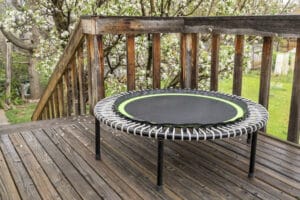What will damage a trampoline?
Key Takeaways
- UV rays can cause material degradation, fading, brittleness, and weakening of the trampoline components. Using a weather cover or placing the trampoline in a shaded area can help protect it from UV damage.
- High temperatures can cause materials to expand and contract, leading to damage. Avoid exposing the trampoline to excessive heat for prolonged periods.
- Rain, snow, and high humidity can accelerate the rusting process of the trampoline’s metal components. Regular inspections, wiping down after rain or snowfall, and ensuring proper drying can help prevent moisture-related damage.
Trampolines are a popular source of outdoor fun and exercise for both children and adults. However, like any piece of equipment, trampolines can be susceptible to damage if not properly maintained or used. Understanding what can damage a trampoline is essential for ensuring its longevity and safety. In this article, we will explore the various factors that can cause damage to a trampoline and provide tips on how to prevent such damage.
Weather and its Impact on Trampoline Lifespan
One of the significant factors that can affect the durability of a trampoline is the weather. Different weather conditions can have diverse effects on the various components of a trampoline.
UV Rays and Material Degradation
The sun’s UV rays can cause materials like the mat, padding, and netting to degrade over time. Prolonged exposure to sunlight can lead to fading, brittleness, and weakening of these components. To protect your trampoline from UV damage, consider using a weather cover when it’s not in use or placing it in a shaded area.
Heat and Material Expansion
High temperatures can cause materials to expand and contract, which can eventually lead to damage. Extreme heat can make the trampoline’s frame and springs more susceptible to bending or breaking. It’s important to be mindful of the temperature and avoid exposing the trampoline to excessive heat for prolonged periods.
Rain, Snow, and Humidity
Rain, snow, and high humidity can accelerate the rusting process of the trampoline’s metal components. Moisture can cause the frame, springs, and other metal parts to corrode, compromising their structural integrity. Regular inspections should be conducted to check for rust and loose hardware. Wiping down the trampoline after rain or snowfall and ensuring it is properly dry can help prevent moisture-related damage.
Frost and Winter Conditions
In colder climates, frost can make the springs and frame of the trampoline brittle and more prone to breaking. Additionally, snow accumulation on the trampoline can exceed its weight limit, causing stress on the jumping mat and springs. It is crucial to remove snow from the trampoline when convenient to prevent damage. Using a weather cover, removing spring pads when not in use, and anchoring the trampoline down can provide added protection against winter weather.
High Winds and Potential Hazards
Strong winds can pose a danger to both the trampoline and surrounding property. Wind gusts can toss the trampoline around, potentially causing damage and injury. To mitigate this risk, it is advisable to anchor the trampoline securely to the ground and position it away from trees, fences, or other structures that may increase wind resistance. Regularly checking the trampoline’s anchoring and stability is essential.
Usage and Maintenance Factors
While weather conditions play a significant role in trampoline damage, proper usage and maintenance are equally crucial. Neglecting maintenance and using the trampoline inappropriately can lead to unnecessary wear and tear.
Proper Set-Up and Assembly
Ensuring the trampoline is set up correctly is vital for its safety and lifespan. Following the manufacturer’s instructions for proper assembly, including the correct placement of springs and bolts, is essential. Failing to assemble the trampoline correctly can result in structural instability and potential damage.
Regular Inspections and Maintenance
Regularly inspecting the trampoline for any signs of wear, tear, or damage is crucial for its longevity. Check for tears, holes, or broken fixtures on the mat, netting, and padding. Ensure that the springs and bolts are properly in place. Replace any damaged fixtures, padding, or netting promptly to maintain the trampoline’s safety and functionality.
Weight Limit and Single-User Rule
Another factor that can contribute to trampoline damage is exceeding the weight limit and allowing multiple users simultaneously. Each trampoline has a specified weight capacity, and exceeding it can strain the jumping mat and springs, leading to premature wear and tear. Additionally, allowing multiple users at the same time can increase the risk of collisions and accidents.
Safe Jumping Practices
Encouraging safe jumping practices is essential for preventing trampoline damage. Discourage high-risk maneuvers like somersaults and flips, as they can put excessive strain on the trampoline’s components. Jumping in the center of the trampoline and avoiding jumping along the edges can help distribute the weight evenly and prevent unnecessary stress on specific areas.
Supervision and Age Restrictions
Proper supervision and age restrictions are crucial for trampoline safety. Children under the age of 6 should not be allowed to use trampolines due to their developing bones and higher risk of injury. Always supervise children when they are using the trampoline and ensure they follow the recommended safety measures.
Conclusion
Trampolines can provide hours of fun and exercise, but they require proper care and maintenance to ensure their longevity. Weather conditions, such as UV rays, heat, rain, snow, and high winds, can all impact the durability of a trampoline. Additionally, using the trampoline correctly, conducting regular inspections, and following safe jumping practices are essential for preventing unnecessary damage. By implementing the recommended maintenance and usage guidelines, you can extend the lifespan of your trampoline and enjoy it for years to come.
Related Websites:
- Common Trampoline Injuries – Living the Outdoor Life
- Trampoline Injury Prevention – American Academy of Orthopaedic Surgeons
- Trampoline Safety: 22 Tips and Cautions – Healthline
- Weather-Resistant Round Trampolines – Trampolines.com
- Trampolines and Winter Weather: Everything You Need to Know – Sunshine and Play
- How Does Weather Affect Trampoline Lifespan? – Trampolinerectangle.com
FAQs:
Q: What weather conditions can damage outdoor trampolines?
Heavy rain, snow, and ice can damage outdoor trampolines. Excessive moisture and weight can harm the frame, springs, and mat.
Q: How does improper installation affect trampoline durability?
Improper installation can lead to tipping or overturning of the trampoline during use. It is crucial to anchor it securely.
Q: What are the potential consequences of exceeding weight limits on a trampoline?
Exceeding weight limits can strain the trampoline structure and increase the risk of accidents. It is essential to follow the recommended weight capacity.
Q: How can user behavior affect the integrity of a trampoline?
Rough or unsafe bouncing, flips, and improper landings can strain the mat, springs, and frame. Jumping near the edges also poses a risk of damage or injury.
Q: Why is proper supervision important when using a trampoline?
Proper adult supervision is crucial while using a trampoline. It helps prevent reckless behavior, reduce accidents, and minimize potential trampoline damage.






